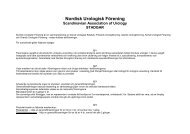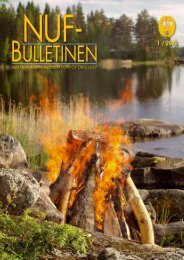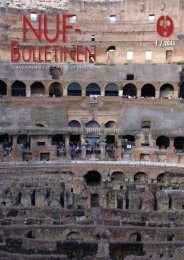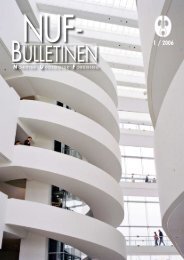NUF Congress 2013 - Scandinavian Association of Urology
NUF Congress 2013 - Scandinavian Association of Urology
NUF Congress 2013 - Scandinavian Association of Urology
Create successful ePaper yourself
Turn your PDF publications into a flip-book with our unique Google optimized e-Paper software.
The passion for painting ...<br />
Figure 5. “Temple in Kyoto”. Canvas130 x 100 cm.<br />
Albeit the smell <strong>of</strong> linseed oil and turpentine<br />
provides an excellent environment<br />
for creative work I nevertheless moved<br />
from oil colours to acrylic colours during<br />
the late 80s because <strong>of</strong> the favourably shorter<br />
drying times with the latter medium,<br />
allowing me to finish the painting while the<br />
inspiration was still there. Painting with<br />
acrylic colours has subsequently been the<br />
main tool <strong>of</strong> my artistic efforts.<br />
So, from where do the painting motifs<br />
come? Usually they do not come from<br />
people around me, because that kind <strong>of</strong><br />
models has always appeared too difficult<br />
to me. In the majority <strong>of</strong> my paintings it is<br />
some impression from nature that I have<br />
tried to interpret. So is for example the<br />
painting in Figure 2 an expression <strong>of</strong> the<br />
early morning light that can be met during<br />
walking in the forest – also a mental and<br />
life saving procedure. Another example <strong>of</strong><br />
impressions from nature is the wood anemones<br />
in Figure 3. It has always been an<br />
advantage for me to combine the painting<br />
with my photographic interest and I always<br />
try to bring a camera for photographs <strong>of</strong><br />
possible use for future paintings.<br />
The sea has always been an attractive<br />
source <strong>of</strong> inspiration and one example <strong>of</strong><br />
that is the 3 x 1 m sea view that is mounted<br />
on the wall in the garden to our house in<br />
Linköping. (Figure 4).<br />
Various more or less spectacular sceneries<br />
have been collected during travelling<br />
abroad. Figure 5 shows a temple in Kyoto<br />
in Japan.<br />
What has happened to all paintings produced<br />
over the years? They have gone in<br />
different directions. Several paintings have<br />
been sold during four exhibitions held in<br />
Stockholm (2005, 2007, 2009 and 2011).<br />
A few have been sold abroad and some<br />
paintings can be found in Karolinska University<br />
hospital. One example <strong>of</strong> that is<br />
the painting in Figure 6 that can be found<br />
in the Tiselius library <strong>of</strong> the department<br />
<strong>of</strong> urology in Huddinge. But <strong>of</strong> course a<br />
substantial number <strong>of</strong> paintings can still<br />
be found in my cellar.<br />
Although my days also after my <strong>of</strong>ficial<br />
retirement so far have been filled by pr<strong>of</strong>essional<br />
activities <strong>of</strong> various kinds, I still<br />
hope to find the time necessary for further<br />
painting attempts.<br />
<strong>NUF</strong>-Bulletinen 1 • <strong>2013</strong><br />
15









